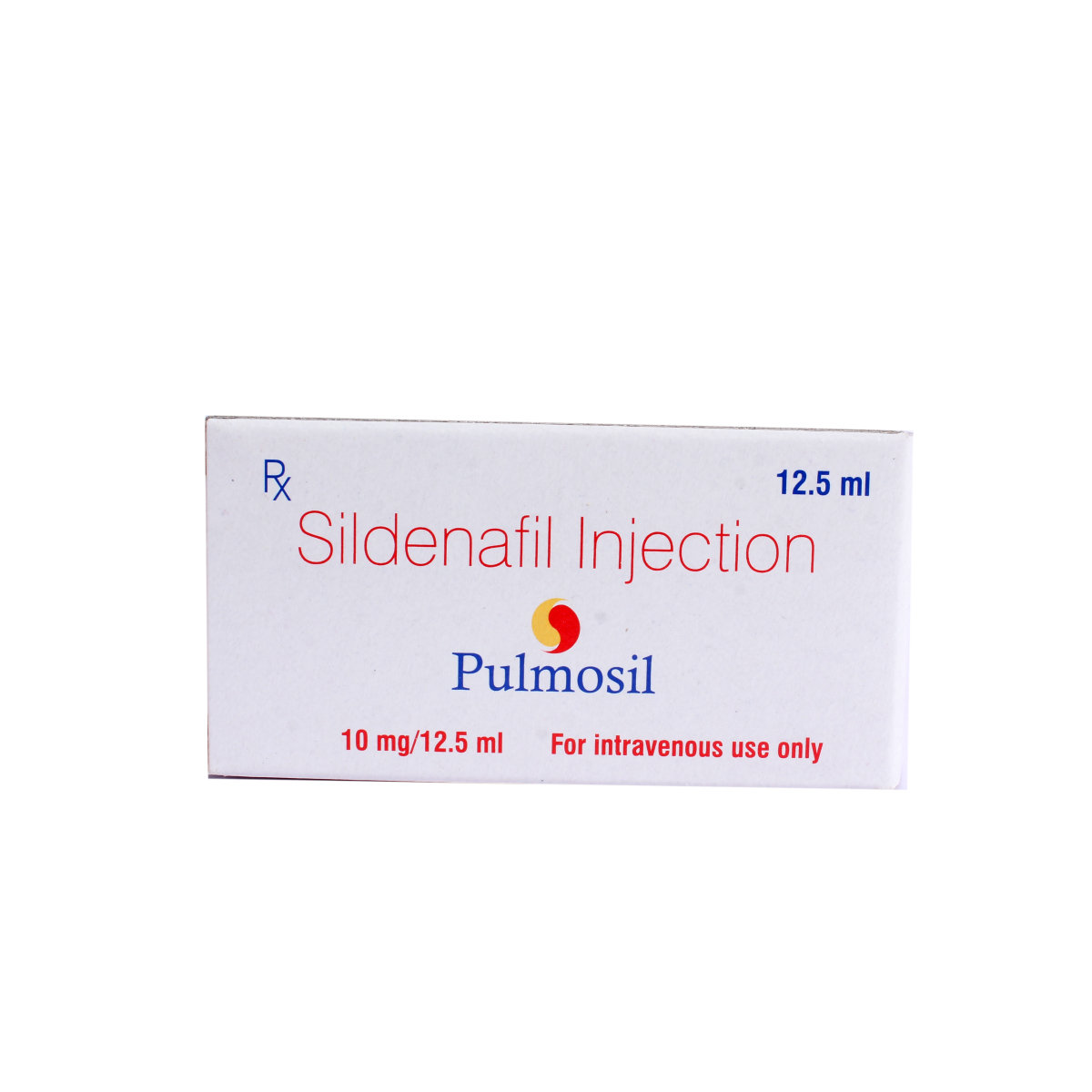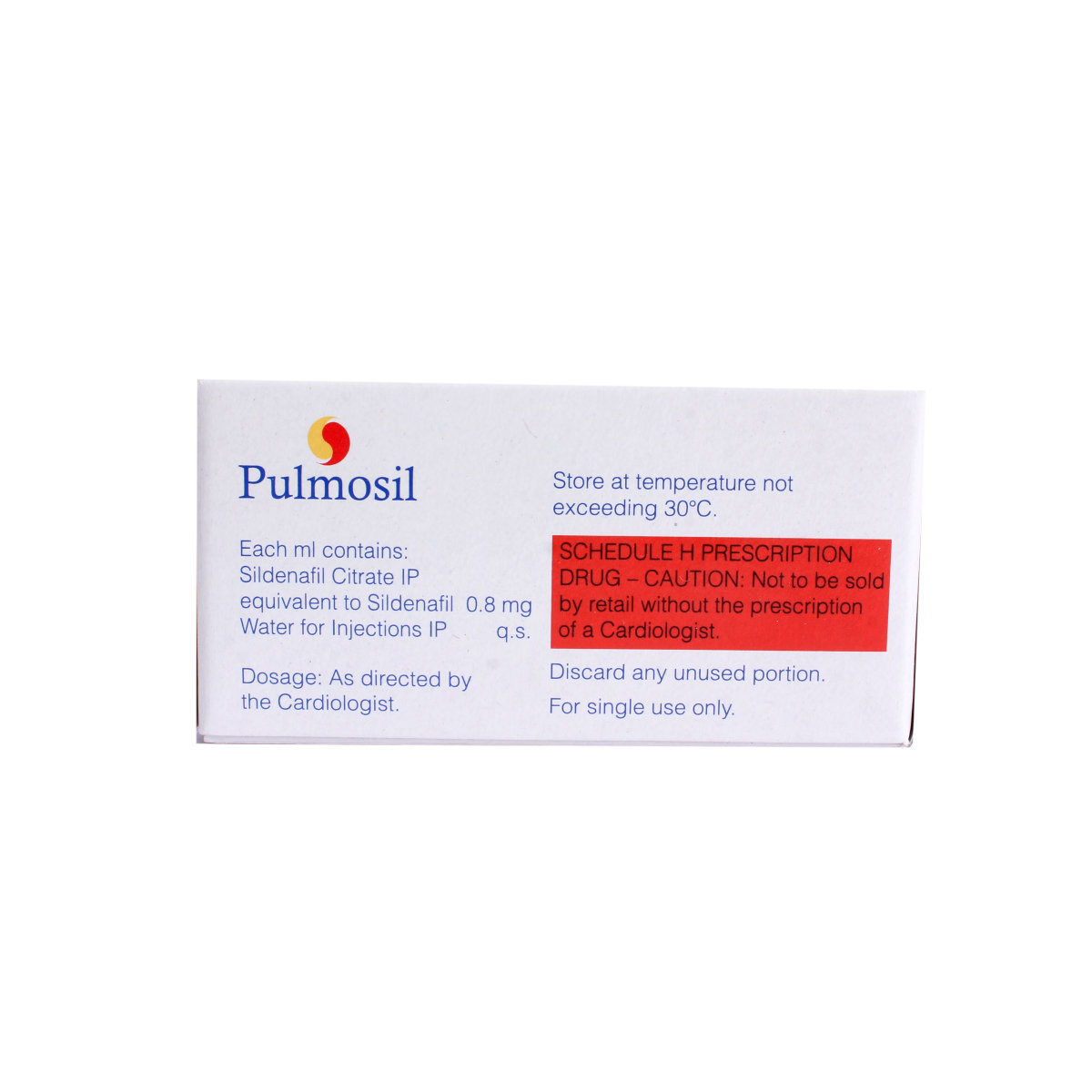Pulmosil Injection 12.5 ml






MRP ₹2057.5
(Inclusive of all Taxes)
₹308.6 Cashback (15%)
Provide Delivery Location
Online payment accepted
 Prescription drug
Prescription drugWhats That
Composition :
Manufacturer/Marketer :
Consume Type :
Expires on or after :
Return Policy :
About Pulmosil Injection 12.5 ml
Pulmosil Injection 12.5 ml belongs to the group of medicines called phosphodiesterase-5 (PDE-5) inhibitors used to treat pulmonary arterial hypertension (high blood pressure in the lungs), to improve the ability to exercise and to slow down clinical worsening.
Pulmosil Injection 12.5 ml contains 'Sildenafil' that relaxes the blood vessels, increases the blood supply to the lungs and reduces the workload of the heart. Thereby, treats pulmonary arterial hypertension.
In some cases, Pulmosil Injection 12.5 ml may cause side effects such as headache, indigestion, flushing, insomnia, and diarrhoea. Most of these side effects do not require medical attention and will resolve gradually over time. However, you are advised to talk to your doctor if you experience these side effects persistently.
Do not take Pulmosil Injection 12.5 ml if you are allergic to any of the components or if you are taking nitrate medicines or riociguat (a drug used to treat pulmonary hypertension). Pulmosil Injection 12.5 ml is not recommended for use in children. Consult your doctor if you experience hearing or visual impairment.
Uses of Pulmosil Injection 12.5 ml
Directions for Use
Key Benefits
Pulmosil Injection 12.5 ml belongs to the group of medicines called phosphodiesterase type-5 (PDE-5) inhibitors used to treat pulmonary arterial hypertension (high blood pressure in the lungs) to improve the ability to exercise and to slow down clinical worsening. Pulmosil Injection 12.5 ml relaxes the blood vessels, increases the blood supply to the lungs and reduces the workload of the heart. Thereby, treats pulmonary arterial hypertension.
Storage
- Hydrate your body: Drink enough water to prevent dehydration and headaches.
- Calm Your Mind: Deep breathing and meditation can help you relax and relieve stress.
- Rest and Recharge: Sleep for 7-8 hours to reduce headache triggers.
- Take rest: lie down in a quiet, dark environment.
- Cold or warm compresses can help reduce tension.
- Stay Upright: Maintain good posture to keep symptoms from getting worse.
- To treat headaches naturally, try acupuncture or massage therapy.
- Over-the-counter pain relievers include acetaminophen and ibuprofen.
- Prescription Assistance: Speak with your doctor about more substantial drug alternatives.
- Severe Headaches: Seek emergency medical assistance for sudden, severe headaches.
- Frequent Headaches: If you get reoccurring headaches, consult your doctor.
- Headaches with Symptoms: Seek medical attention if your headaches include fever, disorientation, or weakness.
- Take medications with food (if recommended): It can help prevent stomach distress and indigestion.
- Eat smaller, more frequent meals: Divide daily food intake into smaller, more frequent meals to ease digestion.
- Avoid trigger foods: Identify and avoid foods that trigger indigestion, such as spicy, fatty, or acidic foods.
- Stay upright after eating: Sit or stand upright for at least 1-2 hours after eating to prevent stomach acid from flowing into the oesophagus.
- Avoid carbonated drinks: Avoid drinking carbonated beverages, such as soda or beer, which can worsen indigestion.
- Manage stress: To alleviate indigestion, engage in stress-reducing activities like deep breathing exercises or meditation.
- Consult a doctor if needed: If indigestion worsens or persists, consult a healthcare professional to adjust the medication regimen or explore alternative treatments.
- Consult your doctor if you experience skin redness, itching, or irritation after taking medication.
- Your doctor may adjust your treatment plan by changing your medication or providing guidance on managing your erythema symptoms.
- Your doctor may recommend or prescribe certain medications to help alleviate symptoms.
- Apply cool compresses or calamine lotion to the affected skin area to reduce redness and itching.
- Stay hydrated by drinking plenty of water to help alleviate symptoms and keep your skin hydrated.
- Monitor your skin condition closely and promptly report any changes, worsening symptoms, or concerns to your healthcare provider.
- Prepare for a restful night's sleep: Develop a calming pre-sleep routine, like reading or meditation, to help your body relax and prepare for sleep.
- Create a sleep-conducive Environment: Make bedroom a sleep haven by ensuring it is quiet, dark and calm.
- Follow a Sleep Schedule: Go to bed and get up at the same time every day to help regulate your body's internal clock and increase sleep quality.
- Try relaxing techniques like deep breathing, mindfulness meditation and any others.
- Limit stimulating activities before bedtime: Avoid stimulating activities before bedtime to improve sleep quality.
- Monitor Progress: Keep track of your sleep patterns to identify areas for improvement.
- Consult a doctor if needed: If these steps don't improve your sleep, consult a doctor for further guidance and therapy.
- Consult your doctor if you experience skin redness, itching, or irritation after taking medication.
- Your doctor may adjust your treatment plan by changing your medication or providing guidance on managing your erythema symptoms.
- Your doctor may recommend or prescribe certain medications to help alleviate symptoms.
- Apply cool compresses or calamine lotion to the affected skin area to reduce redness and itching.
- Stay hydrated by drinking plenty of water to help alleviate symptoms and keep your skin hydrated.
- Monitor your skin condition closely and promptly report any changes, worsening symptoms, or concerns to your healthcare provider.
- Tell your doctor immediately if you experience shortness of breath after taking medication.
- Your doctor may adjust the medication regimen or dosage or give alternative medical procedures to minimize the symptoms of shortness of breath.
- Monitor your oxygen levels and breathing rate regularly to track changes and potential side effects.
- For controlling stress and anxiety, try relaxation techniques like deep breathing exercises, meditation, or yoga.
- Make lifestyle changes, such as quitting smoking, exercising regularly, and maintaining a healthy weight.
- Seek emergency medical attention if you experience severe shortness of breath, chest pain, or difficulty speaking.
- Follow up regularly with your doctor to monitor progress, adjust treatment plans, and address any concerns or questions.
- Consult your doctor if you experience nasal congestion, runny nose, or sinus pressure after taking medication.
- Your doctor may adjust your treatment plan by changing your medication, adding new medications, or providing guidance on managing your rhinitis symptoms.
- If advised by your doctor, use nasal decongestants or saline nasal sprays to help relieve nasal congestion.
- Practice good hygiene, including frequent handwashing, avoiding close contact with others, and avoiding sharing utensils or personal items.
- Stay hydrated by drinking plenty of water and other fluids to help thin out mucus and soothe your nasal passages.
Drug Warnings
Do not take Pulmosil Injection 12.5 ml if you are allergic to any of the components, if you are taking medicines called nitrates which are used to treat angina or chest pain or guanylate cyclase stimulator medicines (medicines used to treat heart failure and PAH). Inform your doctor if you have/had heart problems such as angina, heart attack, irregular heartbeat, or heart failure, blood circulation problems, low blood pressure, eye or ear problems, sickle cell anaemia (an abnormality of red blood cells), multiple myeloma (cancer of bone marrow) or leukaemia (cancer of blood cells), stomach ulcer, bleeding problems, problems with the shape of the penis or Peyronie's disease (a condition that causes painful erections).
Drug-Drug Interactions
Drug-Drug Interactions
Login/Sign Up
Coadministration of Isosorbide dinitrate and Pulmosil Injection 12.5 ml can increase the risk of low blood pressure.
How to manage the interaction:
Taking Isosorbide dinitrate and Pulmosil Injection 12.5 ml together is generally avoided as it can lead to an interaction, it can be taken only if advised by your doctor. However, if you experience dizziness, lightheadedness, fainting, headache, flushing, heart palpitations, and priapism (prolonged and painful erection unrelated to sexual activity) contact your doctor immediately. Do not discontinue any medications without first consulting your doctor.
Co-administration of Pulmosil Injection 12.5 ml with Riociguat may lower the blood pressure.
How to manage the interaction:
Taking Riociguat and Pulmosil Injection 12.5 ml together is generally avoided as it can lead to an interaction, it can be taken if advised by your doctor. However, if you experience any symptoms like dizziness, lightheadedness, fainting, flushing, headache, and nasal congestion, contact a doctor immediately. Do not discontinue any medications without consulting a doctor.
Coadministration of Amprenavir and Pulmosil Injection 12.5 ml can increase the blood levels and effects of Pulmosil Injection 12.5 ml.
How to manage the interaction:
Taking Amprenavir and Pulmosil Injection 12.5 ml together is not recommended as it can lead to an interaction, it can be taken if advised by your doctor. However, if you experience any symptoms like nausea, shortness of breath, dizziness, lightheadedness, fainting, visual disturbances, ringing in the ears, vision or hearing loss, chest pain or tightness, irregular heartbeat, and/or priapism (prolonged and painful erection unrelated to sexual activity), contact your doctor immediately. Do not discontinue any medications without first consulting your doctor.
Coadministration of Indinavir and Pulmosil Injection 12.5 ml can increase the blood levels and side effects of Pulmosil Injection 12.5 ml.
How to manage the interaction:
Taking Indinavir and Pulmosil Injection 12.5 ml together is avoided as it can lead to an interaction, it can be taken if advised by your doctor. However, if you experience any symptoms like nausea, shortness of breath, dizziness, lightheadedness, fainting, visual disturbances, ringing in the ears, vision or hearing loss, chest pain or tightness, irregular heartbeat, and/or priapism (prolonged and painful erection unrelated to sexual activity), contact your doctor immediately. Do not discontinue any medications without first consulting your doctor.
Combining Amyl nitrite and Pulmosil Injection 12.5 ml can increase the risk or severity of lower blood pressure.
How to manage the interaction:
Taking Amyl nitrite and Pulmosil Injection 12.5 ml together is avoided as it can lead to an interaction, it can be taken only when advised by your doctor. However, if you experience any symptoms like dizziness, lightheadedness, fainting, headache, flushing, heart palpitations, and priapism (prolonged and painful erection unrelated to sexual activity), contact your doctor immediately. Do not discontinue any medications without first consulting your doctor.
Coadministration of Fosamprenavir and Pulmosil Injection 12.5 ml can increase the blood levels and effects of Pulmosil Injection 12.5 ml.
How to manage the interaction:
Taking Fosamprenavir and Pulmosil Injection 12.5 ml together is not recommended as it can lead to an interaction, it can be taken if advised by your doctor. However, if you experience any symptoms like nausea, shortness of breath, dizziness, lightheadedness, fainting, visual disturbances, ringing in the ears, vision or hearing loss, chest pain or tightness, irregular heartbeat, and/or priapism (prolonged and painful erection unrelated to sexual activity), contact your doctor immediately. Do not discontinue any medications without first consulting your doctor.
Combining Telaprevir and Pulmosil Injection 12.5 ml can increase the blood levels and effects of Pulmosil Injection 12.5 ml.
How to manage the interaction:
Taking Telaprevir and Pulmosil Injection 12.5 ml together is not recommended as it can lead to an interaction, it can be taken if advised by your doctor. However, if you experience any symptoms like nausea, shortness of breath, dizziness, lightheadedness, fainting, visual disturbances, ringing in the ears, vision or hearing loss, chest pain or tightness, irregular heartbeat, and/or priapism (prolonged and painful erection unrelated to sexual activity), contact your doctor immediately. Do not discontinue any medications without first consulting your doctor.
Combining Darunavir and Pulmosil Injection 12.5 ml can increase the blood levels and effects of Pulmosil Injection 12.5 ml.
How to manage the interaction:
Taking Darunavir and Pulmosil Injection 12.5 ml together is avoided as it can lead to an interaction, it can be taken if advised by your doctor. However, if you experience any symptoms like nausea, shortness of breath, dizziness, lightheadedness, fainting, visual disturbances, ringing in the ears, vision or hearing loss, chest pain or tightness, irregular heartbeat, and/or priapism (prolonged and painful erection unrelated to sexual activity), contact your doctor immediately. Do not discontinue any medications without first consulting your doctor.
Coadministration of Ritonavir and Pulmosil Injection 12.5 ml may significantly increase the blood levels of Pulmosil Injection 12.5 ml.
How to manage the interaction:
Taking Pulmosil Injection 12.5 ml with Ritonavir together is generally avoided as it can possibly result in an interaction, it can be taken only if your doctor has advised it. If you notice any of these symptoms like nausea, shortness of breath, dizziness, lightheadedness, fainting, visual disturbances, ringing in the ears, vision or hearing loss, chest pain or tightness, irregular heartbeat, and/or priapism (prolonged and painful erection unrelated to sexual activity), contact a doctor. Do not discontinue any medications without consulting a doctor.
Coadministration of Pulmosil Injection 12.5 ml with Nitroprusside can increase the risk of developing low blood pressure.
How to manage the interaction:
Taking Pulmosil Injection 12.5 ml with Nitroprusside together is generally avoided as it can lead to an interaction, it can be taken only if prescribed by your doctor. If you experience any side effects such as dizziness, lightheadedness, headache, or heart palpitations you should seek immediate medical attention. Do not discontinue any medications without consulting your doctor.
Drug-Food Interactions
Drug-Food Interactions
Login/Sign Up
Diet & Lifestyle Advise
- Lower your intake of salt. This helps in reducing the risk of developing oedema.
- Include vegetables, fruits, whole grains, lean meats, poultry, fish, and fat-free/low-fat dairy products in your diet.
- Avoid canned foods, processed foods, pickled, and frozen food. Instead, consume fresh foods.
- Limit consumption of caffeine and alcohol as they can alter blood pressure.
- Monitor fluid intake to prevent swelling/fluid retention.
Side Effects of Pulmosil Injection 12.5 ml
- Headache
- Indigestion
- Flushing
- Insomnia (sleep disorder)
- Diarrhoea
Habit Forming
Therapeutic Class
All Substitutes & Brand Comparisons
RX
Out of StockCyldena 10 mg Injection 12.5 ml
Neon Laboratories Ltd
₹2400
(₹172.8/ 1ml)
16% COSTLIERRX
Assurans 0.8Mg Injection 10Mg/12.5Ml
Cipla Ltd
₹2717.5
(₹195.66/ 1ml)
32% COSTLIER
Author Details
We provide you with authentic, trustworthy and relevant information
Drug-Diseases Interactions
Drug-Diseases Interactions
Login/Sign Up
FAQs
Pulmosil Injection 12.5 ml relaxes the blood vessels, increases the blood supply to the lungs and reduces the workload of the heart. Thereby, treats pulmonary arterial hypertension.
Diarrhoea might be a side effect of Pulmosil Injection 12.5 ml. Eat non-spicy food and drink fluids if you experience diarrhoea. Consult your doctor if the condition persists or worsens.
Do not to take Pulmosil Injection 12.5 ml with nitrates. Taking Pulmosil Injection 12.5 ml with medicines used to treat angina/chest pain such as nitrates/nitroglycerin may cause severe lowering of blood pressure. Consult your doctor if you have a history of heart attack/stroke.
Pulmosil Injection 12.5 ml has vasodilation properties which may cause low blood pressure (hypotension). Therefore, inform your doctor if you have resting hypotension, fluid depletion, autonomic dysfunction (dysfunction of the nerves), or severe left ventricular outflow obstruction.
When taken along with vitamin K antagonists, Pulmosil Injection 12.5 ml might increase the risk of bleeding. Consult your doctor if you are taking any vitamin K antagonists.
Drug-Drug Interactions Checker List
- RIOCIGUAT
- RITONAVIR
- AMLODIPINE
Disease/Condition Glossary
Pulmonary arterial hypertension (PAH): High blood pressure affects the arteries in the lungs and heart leading to pulmonary arterial hypertension. It occurs due to narrowed or blocked blood vessels which increases the workload on the heart. Symptoms include chest pain, dizziness, fatigue, and swelling in the legs and ankles.

Have a query?
Buy best Genito Urinary products by
Cipla Ltd
Sun Pharmaceutical Industries Ltd
Intas Pharmaceuticals Ltd
Ipca Laboratories Ltd
Leeford Healthcare Ltd
Dr Reddy's Laboratories Ltd
Lupin Ltd
Alkem Laboratories Ltd
Msn Laboratories Pvt Ltd
Zydus Healthcare Ltd
Demorbus India Pvt Ltd
Mankind Pharma Pvt Ltd
Overseas Health Care Pvt Ltd
RPG Life Sciences Ltd
La Renon Healthcare Pvt Ltd
Alembic Pharmaceuticals Ltd
Corona Remedies Pvt Ltd
Macleods Pharmaceuticals Ltd
Aristo Pharmaceuticals Pvt Ltd
Fourrts India Laboratories Pvt Ltd
Tas Med India Pvt Ltd
Micro Labs Ltd
Samarth Life Sciences Pvt Ltd
Zydus Cadila
Emcure Pharmaceuticals Ltd
Hetero Drugs Ltd
Ignyx Pharmaceuticals
Renspur Healthcare Pvt Ltd
Steris Healthcare
Alniche Life Sciences Pvt Ltd
Septalyst Lifesciences Pvt Ltd
Ajanta Pharma Ltd
Elder Pharmaceuticals Ltd
Merynova Life Sciences India Pvt Ltd
Tppl Pharmaceuticals Pvt Ltd
Walter Bushnell
Aar Ess Remedies Pvt Ltd
Knoll Healthcare Pvt Ltd
Lividus Pharmaceuticals Pvt Ltd
Meditrex Pharma
Medrhans Pharmaceuticals Pvt Ltd
Neuten HealthCare
Redmed Medical Services
Talohsty Medmark Pvt Ltd
Zycris Healthcare
East West Pharma India Pvt Ltd
Globus Remedies Ltd
Golden Square Lab Pvt Ltd
Hetero Healthcare Pvt Ltd
Modi Mundipharma Pvt Ltd
Nephurocare Pharma Pvt Ltd
Pfizer Ltd
TTK Healthcare Ltd
Votary Laboratories (India) Ltd
Albus Healthcare Pvt Ltd
Delvin Formulations (P) Ltd
Indoco Remedies Ltd
Intra Life Pvt Ltd
Megma Healthcare Pvt Ltd
Morepen Laboratories Ltd
Qren Life Sciences Pvt Ltd
Steadfast MediShield Pvt Ltd
Unipark Biotech Pvt Ltd
Akumentis Healthcare Ltd
Biokindle Lifesciences Pvt Ltd
Calren Care Lifesciences Pvt Ltd
Chemo Biological Ltd
Chemo Healthcare Pvt Ltd
Euniche Life Sciences
Himeros Pharmaceuticals Pvt Ltd
Hospimax Healthcare Pvt Ltd
Kiosence Health Care Pvt Ltd
Lia Life Sciences Pvt Ltd
Panacea Biotec Ltd
Primus Remedies Pvt Ltd
Rencord Life Sciences Pvt Ltd
Shilpa Medicare Ltd
Stadmed Pvt Ltd
Abbott India Ltd
Ameya Pharmaceuticals & Chemicals Pvt Ltd
Ardent Life Sciences Pvt Ltd
Asterima Pharmaceuticals Pvt Ltd
Astrum Healthcare Pvt Ltd
Cadila Healthcare Ltd
De Renon
Fibovil Pharmaceuticals Pvt Ltd
Koye Pharmaceuticals Pvt Ltd
Linux Laboratories Pvt Ltd
MMC Healthcare Ltd
Neovae Biomedics Pvt Ltd
Olcare Laboratories Pvt Ltd
Oxygen Pharma Care Pvt Ltd
Prevego Healthcare & Research Pvt Ltd
Rene Lifescience
Sanzyme Pvt Ltd
Solis Ortus Remedies Pvt Ltd
Syndicate Life Sciences Pvt Ltd
Tycoon Pharmaceuticals Pvt Ltd
Vasu Organics Pvt Ltd
Walron Health Care Pvt Ltd
Alcohol
Safe if prescribed
It is not known if alcohol affects Pulmosil Injection 12.5 ml. Please consult your doctor.
Pregnancy
Consult your doctor
Consult your doctor if you are pregnant. Your doctor will prescribe only if the benefits outweigh the risks.
Breast Feeding
Consult your doctor
It is not known if Pulmosil Injection 12.5 ml passes into breastmilk. Consult your doctor if you are breastfeeding. Your doctor will prescribe only if the benefits outweigh the risks.
Driving
Safe if prescribed
Pulmosil Injection 12.5 ml may cause dizziness; therefore, you are advised to drive and operate machinery only if you are alert.
Liver
Consult your doctor
Please consult your doctor if you have any concerns regarding the usage of Pulmosil Injection 12.5 ml in patients with liver impairment/liver disease.
Kidney
Consult your doctor
Please consult your doctor if you have any concerns regarding the usage of Pulmosil Injection 12.5 ml in patients with kidney disease.
Children
Safe if prescribed
Pulmosil Injection 12.5 ml is not recommended for children as safety and effectiveness have not been established.





_0.jpg?tr=q-85)

